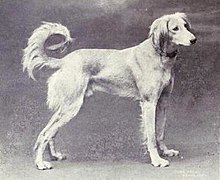| Country of origin | Middle Eastern Region |
|---|
The Saluki, also known as the Royal Dog of Egypt and Persian Greyhound (Persian: سلوکی, Arabic: سلوقی) is one of the oldest known breeds of domesticated dog. From the period of the Middle Kingdom onwards, Saluki-like animals appear on the ancient Egyptian tombs of 2134 BC. They have connections both to the Bible and Imperial China. Modern breeding in the west began in 1895 when Florence Amherst imported a breeding pair of Salukis from Lower Egypt and began working to popularize the breed. Salukis were recognized by The Kennel Club in 1923, and by the American Kennel Club in 1929.
The Saluki is a sighthound and historically travelled throughout the Middle East with nomadic desert tribes over an area stretching from theSahara to the Caspian Sea. Accepted as clean by the Islamic faith,[citation needed] they have been used to hunt quarry such as gazelles in the Middle East. Shaped like a typical sighthound, they come in two varieties, smooth and feathered. The feathered variety is more common, and the breed is known for the hair on its ears, tail and the back of its legs. Though they are an independent breed that needs patient training, they are gentle and affectionate with their owners. Health issues include cancer and cardiac problems.
History
Salukis are considered to be one of the oldest dog breeds in existence, with excavations of Sumerian Empire sites between 7000-6000 BC showing carvings and seals that look similar to the modern breed. Its name is thought to come from the ancient Arabian town of Suluk, Libya, although in the modern era it has also been called the Gazelle Hound, Arabian Hound or Persian Greyhound. From Sumer, the nomadic tribes spread the breed across the Middle East from Egypt and Persia, to as far east as Afghanistan and India, and as far south as Sudan.
They were considered to be the "Royal Dog of Egypt". Salukis appear on Egyptian tombs increasingly commonly from The Middle Kingdom (2134 BC - 1785 BC) onward, and have often been found mummified alongside the bodies of the Pharaohs in the Pyramids. It was during the Eighteenth dynasty of Egypt that Salukis rose to their place of prominence, replacing the Tesem (thought to be similar to modern Pariah dogs, or a generic term for a dog).
The breed is thought to be the type of dog mentioned in The Bible. Salukis have appeared in medievalpaintings regarding the birth of Christ, including Paolo Veronese's 1573 work the Adoration of the Magi (also known as the Adoration of the Kings), currently located at the National Gallery, London. Veronese also painted the breed into some of his other religious work, including The Marriage at Cana and The Finding of Moses.
Salukis had entered China by the time of the Tang Dynasty (618–907), and examples of the breed were painted by the fifth Ming Emperor Zhū Zhānjī, known more commonly as the Xuande Emperor. The inscription on the painting reads "playfully painted [by the] imperial brush" in 1427. Additional red seals were added in later years by owners of the painting, which also reveals that the painting was in the Imperial Chinese collection in the 18th century.
Today, the breed is still held in high regard throughout the Middle East, and have been hunting dogs for nobles and rulers around the region. They are considered clean by the Bedouins, and are allowed to be in women's quarters, while other dogs must be kept outside. This is similar to elsewhere in the Muslim world, with the breed proclaimed in the Koran as the "gift of Allah". Sheik Hamad ibn Isa Al Khalifa, King of Bahrain during the 1930s, was known for a pack of Salukis that accompanied him throughout the Arab world on hunting trips. Following his death, his son Salman ibn Hamad Al Khalifaattempted to keep the lines pure-bred but they became interbred with other breeds. However, the pure-bred lines of the royal kennel were saved by the efforts of Dana Al Khalifa who was given two pure-bred puppies by the King, and about a decade later had around pure-bred Salukis registered with the Kennel Club of Bahrain.










No comments:
Post a Comment